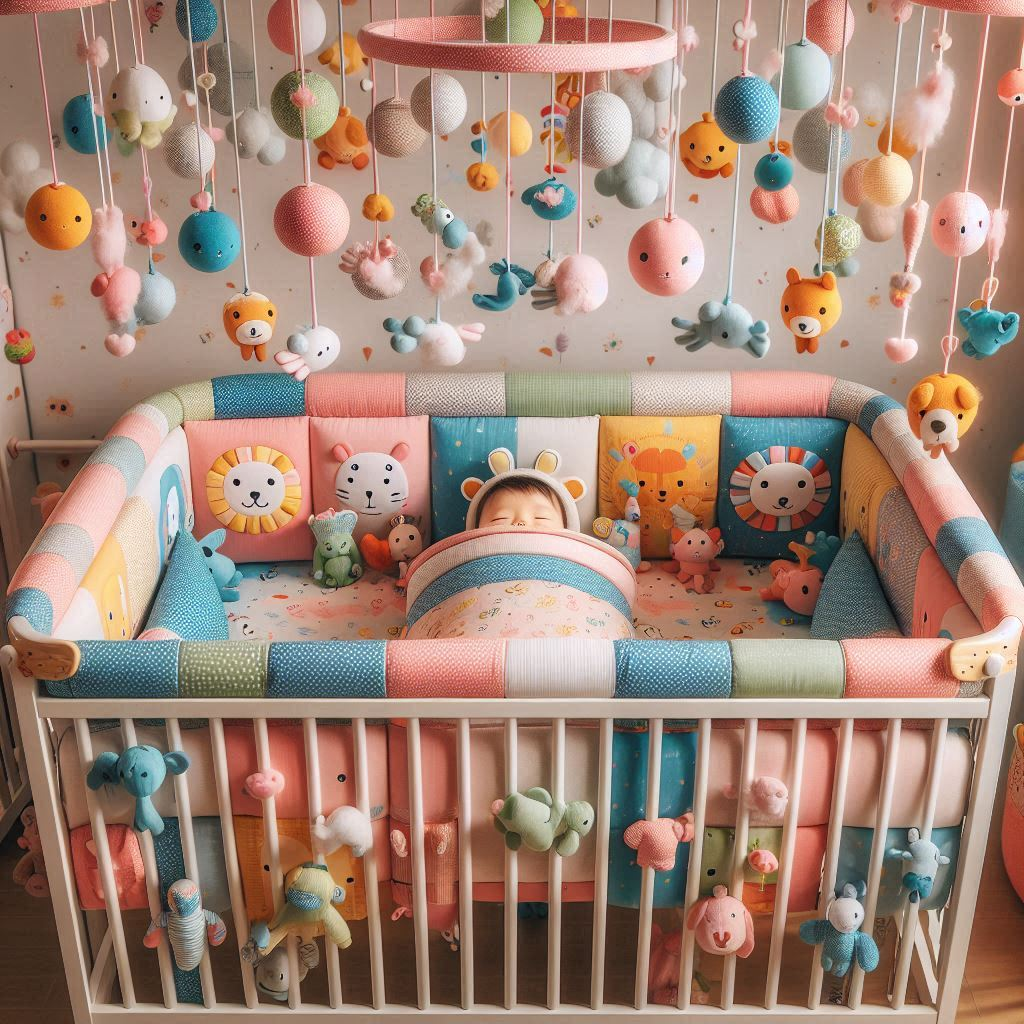Bumper Pads for Cribs for Baby
As a new parent, you want to create the safest and coziest space for your little one. When it comes to setting up the nursery, you might have heard about bumper pads for cribs. But what exactly are they, and are they safe? Let’s dive into this important topic and explore everything you need to know about crib bumpers.
Quick Answer
Crib bumper pads are no longer recommended due to safety concerns. The American Academy of Pediatrics advises against their use, and they’re now banned in the United States. Safer alternatives like sleep sacks are preferred for creating a secure sleep environment for babies.
My Personal Experience with Crib Bumpers
When I was pregnant with my first child, I remember walking into a baby store and being drawn to the adorable crib sets with matching bumpers. They looked so soft and cozy! I thought to myself, “This is exactly what my baby needs.” Little did I know, I was about to learn an important lesson about baby safety.
I picked up a set of pastel-colored bumpers, running my hand over the plush fabric. “These will keep the baby from bumping their head,” I mused aloud.
An older woman nearby overheard me. She gently touched my arm and said, “Honey, I know they look cute, but those aren’t safe for babies. My daughter just had a baby, and her doctor told her to avoid bumpers completely.”
I was shocked. How could something designed for babies be unsafe? That conversation sparked my journey to learn everything I could about crib safety.
This experience taught me that what looks good isn’t always what’s best for our little ones. It’s a lesson I’m grateful I learned before bringing my baby home.
What Are Crib Bumper Pads?
Crib bumper pads are padded liners that attach to the inside of a baby’s crib slats. They were originally designed with good intentions – to prevent a baby’s head from getting stuck between crib slats and to protect against bumps and bruises.
Types of Crib Bumper Pads
- Traditional Padded Bumpers: Thick, pillow-like pads that tie to crib slats.
- Mesh Liners: Thin, breathable barriers that allow air flow.
- Vertical Crib Liners: Individual padded strips that cover each crib slat.
- Braided Bumpers: Long, woven tubes that wrap around crib rails.
The Safety Debate: Why Crib Bumpers Are No Longer Recommended
Despite their initial purpose, crib bumpers have become a hot topic in child safety discussions. Let’s break down the main concerns:
1. Suffocation Risk
The biggest worry is that a baby could press their face against a bumper and not be able to breathe. Babies don’t have the strength to turn their heads if they get stuck, which can lead to suffocation.
2. Strangulation Hazard
The ties used to attach bumpers to the crib can come loose. If this happens, they could wrap around a baby’s neck.
3. Entrapment Danger
As babies start to move around more, they might get trapped between the bumper and the mattress. This is especially risky if the bumper is loose or sagging.
4. Climbing Aid for Toddlers
Once babies grow into curious toddlers, they might use the bumper as a step to climb out of the crib. This increases the risk of falls.
What Do the Experts Say?
The American Academy of Pediatrics (AAP) has been clear in their stance against crib bumpers since 2011. They recommend that babies sleep on their backs in a bare crib with no soft objects or loose bedding.
In 2022, the U.S. Consumer Product Safety Commission (CPSC) took a big step. They banned the sale of padded crib bumpers nationwide. This ban was part of the Safe Sleep for Babies Act, which aims to create safer sleep environments for infants.
The Bare Crib Movement: Less is More
With the push for safer sleep practices, many parents are embracing the “bare is best” approach to crib setups. This means:
- A firm mattress with a tight-fitting sheet
- No pillows, blankets, or stuffed animals
- No crib bumpers or padding
- Baby dressed in sleep-appropriate clothing
This minimalist approach might seem stark, but it’s designed to reduce the risk of Sudden Infant Death Syndrome (SIDS) and other sleep-related dangers.
Safer Alternatives to Crib Bumpers
If you’re worried about your baby’s comfort and safety without bumpers, don’t fret! There are safer options available:
1. Sleep Sacks
These wearable blankets keep baby warm without the need for loose bedding. They come in different thicknesses for various seasons.
2. Breathable Mesh Liners
While not entirely risk-free, these allow for better air flow if a baby rolls against them. However, they should still be used with caution.
3. Properly Sized Cribs
Modern cribs are designed with slats close enough together that a baby’s head can’t get stuck. This eliminates one of the original reasons for bumpers.
Creating a Safe Sleep Environment: Beyond the Bumpers
Ensuring your baby’s safety during sleep goes beyond just avoiding bumpers. Here are some key tips for a safe sleep setup:
- Back to Sleep: Always place babies on their backs to sleep, for naps and at night.
- Firm Surface: Use a firm sleep surface, like a mattress in a safety-approved crib.
- Room-Sharing: Keep baby’s sleep area in the same room where you sleep for the first 6 months, or ideally, for the first year.
- No Soft Objects: Keep soft objects, loose bedding, or any objects that could increase the risk of entrapment, suffocation, or strangulation out of the crib.
- Avoid Overheating: Dress your baby in sleep clothing, such as a wearable blanket. Don’t overbundle.
The Emotional Side of Crib Safety
As parents, we often struggle with the gap between what looks cozy and what’s actually safe. It’s normal to feel conflicted when you see a beautifully decorated nursery in a magazine, complete with plush bumpers and blankets, knowing that it’s not the safest setup for your baby.
Remember, your love and care for your baby isn’t measured by how cushioned their crib is. A bare crib might look plain to us, but for a baby, it’s a safe haven where they can rest and grow.
Frequently Asked Questions About Crib Safety
Q: Can I use crib bumpers for a short time, like during the newborn stage?
A: No, it’s not recommended to use crib bumpers at any stage. The risks are present from birth onwards.
Q: What about breathable mesh liners? Are those safe?
A: While mesh liners are marketed as a safer alternative, they’re not risk-free. The AAP recommends against using any type of crib liner.
Q: My baby keeps getting their legs stuck between the crib slats. What can I do?
A: This is a common concern, but it’s generally not harmful to the baby. If it’s disrupting their sleep, consider using a sleep sack, which can limit their ability to stick their legs out.
Q: Is it okay to use crib bumpers for decoration during the day and remove them at night?
A: It’s best to avoid using crib bumpers altogether. There’s always a risk of forgetting to remove them, and babies often nap during the day.
Wrapping Up: Safety First in the Nursery
As we’ve explored, the world of crib safety has changed a lot in recent years. What was once a nursery staple – the crib bumper – is now understood to be a potential hazard. While it might feel strange to put your baby in a bare crib, remember that you’re providing them with the safest possible sleep environment.
Parenting often involves balancing what looks nice with what’s best for our children. In the case of crib bumpers, the choice is clear: a bare crib is a safer crib. By focusing on the essentials – a firm mattress, tight-fitting sheet, and appropriate sleep wear – you’re giving your baby the best start in life.
As you set up your nursery, remember my story. Sometimes, the best advice comes from unexpected places, and it’s okay to change your mind as you learn more. Your baby doesn’t need fancy decorations to feel loved and secure. Your care and attention are the most important things you can provide.
Next Steps for Parents
- Review your current crib setup and remove any bumpers or soft objects.
- Invest in a few good quality sleep sacks for safe and cozy sleep.
- Share this information with other parents or soon-to-be parents in your life.
- If you have concerns about your baby’s sleep safety, don’t hesitate to talk to your pediatrician.
Remember, every baby is unique, but safe sleep practices are universal. By staying informed and making safety-conscious choices, you’re doing an amazing job as a parent. Sweet dreams to you and your little one!

Jessica Winter is a passionate parenting blogger with two years of experience guiding new and seasoned parents through the joys and challenges of raising babies. Her insightful posts blend personal anecdotes with expert advice to offer a warm and practical perspective on modern parenting.

